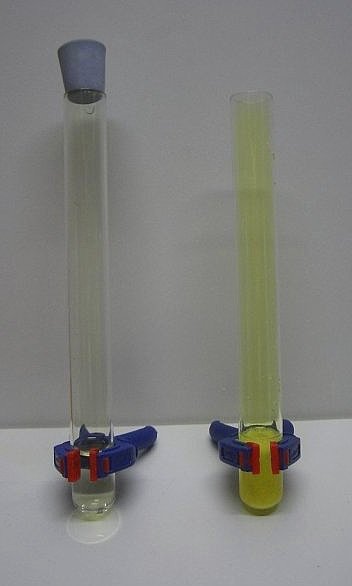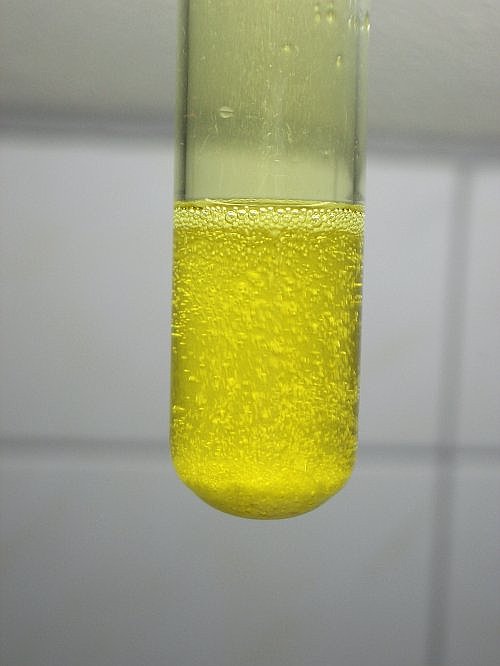


Colored gases - chlorine and chlorine dioxide
In this experiment two colored gases are made. This experiment nicely demonstrates the difference in intensity of the color of the two gases, while the colors themselves are fairly close to each other.
 This
experiment involves the formation of a very unstable gas. When the experiment is
done carelessly, this may result in an explosion. Carefully follow the
instructions below and do not scale up and do not attempt to concentrate the gas
in a confined space.
This
experiment involves the formation of a very unstable gas. When the experiment is
done carelessly, this may result in an explosion. Carefully follow the
instructions below and do not scale up and do not attempt to concentrate the gas
in a confined space.
![]()
![]() Required
chemicals:
Required
chemicals:
-
calcium hypochlorite, or bleach with 10% active chlorine, the cheapest stuff there is, without additives
-
sodium chlorate
-
concentrated hydrochloric acid, approximately 30% by weight
-
dilute hydrochloric acid, approximately 10% by weight
![]() Required
equipment:
Required
equipment:
-
test tubes
- clamps
- rubber stopper
![]() Safety:
Safety:
- bleach is corrosive and caustic;
- hydrochloric acid is corrosive, the concentrated acid gives off fumes, which are very noxious;
-
 the gases produced are very noxious and this experiment must be done
outside or in a very well ventilated area, standard kitchen exhaust is
not sufficient;
the gases produced are very noxious and this experiment must be done
outside or in a very well ventilated area, standard kitchen exhaust is
not sufficient; -

 chlorine dioxide
is a very unstable compound when pure or when at high pressure. Do not
attempt to collect large amounts of this gas in a confined space. The gas is
notoriously explosive and can explode, apparently without any reason, when
its partial pressure exceeds approximately 1 atm.
chlorine dioxide
is a very unstable compound when pure or when at high pressure. Do not
attempt to collect large amounts of this gas in a confined space. The gas is
notoriously explosive and can explode, apparently without any reason, when
its partial pressure exceeds approximately 1 atm. - sodium chlorate is a strong oxidizer;
- calcium hypochlorite is a strong oxidizer.
![]() Disposal:
Disposal:
- The waste can be flushed down the drain with a lot of water
![]()
Procedure for performing the experiment
![]() Put a
spatula full of calcium hypochlorite or approximately 2 ml of bleach in a test
tube and add two to three ml of dilute hydrochloric acid. Do this slowly and
carefully, as the reaction can be quite vigorous with liquid foaming out of the
test tube. Let reaction proceed and when bubbling ceases, loosely stopper the
test tube with a rubber stopper. A light green gas can be observed.
Put a
spatula full of calcium hypochlorite or approximately 2 ml of bleach in a test
tube and add two to three ml of dilute hydrochloric acid. Do this slowly and
carefully, as the reaction can be quite vigorous with liquid foaming out of the
test tube. Let reaction proceed and when bubbling ceases, loosely stopper the
test tube with a rubber stopper. A light green gas can be observed.
![]() Put a
spatula full of sodium chlorate in a test tube and add a few ml of concentrated
hydrochloric acid. The liquid will start bubbling and foaming. The reaction,
however is less vigorous than with the calcium hypochlorite. An intensely
colored yellow/green gas mixture can be observed. The liquid becomes deep
yellow.
Put a
spatula full of sodium chlorate in a test tube and add a few ml of concentrated
hydrochloric acid. The liquid will start bubbling and foaming. The reaction,
however is less vigorous than with the calcium hypochlorite. An intensely
colored yellow/green gas mixture can be observed. The liquid becomes deep
yellow. ![]() Do not
stopper this test tube, as this might result in a too high partial pressure of
chlorine dioxide.
Do not
stopper this test tube, as this might result in a too high partial pressure of
chlorine dioxide.
![]() The green gas is
chlorine, Cl2, and the deep yellow/green gas is impure ClO2.
Both gases are toxic and corrosive and one should be careful not to breathe
these gases. Luckily, the warning level of these gases is good. Even breathing a
tiny amount of these gases already is experienced as a very unpleasant event.
The green gas is
chlorine, Cl2, and the deep yellow/green gas is impure ClO2.
Both gases are toxic and corrosive and one should be careful not to breathe
these gases. Luckily, the warning level of these gases is good. Even breathing a
tiny amount of these gases already is experienced as a very unpleasant event.
The following picture shows both test tubes. The left one contains fairly pure chlorine gas. Only a faint green color can be observed, because of the fact that only a thin layer of gas is viewed. The right one contains a mixture of approximately 50% chlorine and 50% chlorine dioxide. It is remarkable how intense the yellow color is for even this thin layer of gas.

The following picture shows a close up of the right test tube with the evolution of the chlorine/chlorine dioxide mixture. The solid at the bottom is the sodium chlorate added, partially converted to sodium chloride, which is almost insoluble in concentrated hydrochloric acid. The liquid is deep yellow as well. This is due to dissolved chlorine dioxide.

![]()
Discussion of results
![]() Ordinary household bleach contains hypochlorite ions, ClO–,
together with chloride, Cl–, and hydroxide, OH–. It is
produced by electrolysis and constantly mixing of brine or by passing chlorine
through a solution of sodium hydroxide. When this is added to hydrochloric acid,
then the following net reaction occurs (the actual mechanism behind the reaction
is quite complex):
Ordinary household bleach contains hypochlorite ions, ClO–,
together with chloride, Cl–, and hydroxide, OH–. It is
produced by electrolysis and constantly mixing of brine or by passing chlorine
through a solution of sodium hydroxide. When this is added to hydrochloric acid,
then the following net reaction occurs (the actual mechanism behind the reaction
is quite complex):
ClO– + Cl– + 2H+ → Cl2(g) + H2O
With solid calcium hypochlorite a similar reaction occurs.
![]() The
reaction of chlorate with concentrated hydrochloric acid is very complex. Two possible idealized 'extremes'
can be given for the reaction equation. The
net real reaction will be a
linear combination of these two extremes, resulting in a gaseous mixture of
approximately 50% Cl2 and 50% ClO2 and a higher percentage
of ClO2 in the liquid (this gas dissolves better in water than does
Cl2). The exact ratio cannot easily be determined and depends
on the concentration of the acid and on the temperature. Pure chlorine or pure
chlorine dioxide can, however, never be obtained with the reaction between a
chlorate and hydrochloric acid.
The
reaction of chlorate with concentrated hydrochloric acid is very complex. Two possible idealized 'extremes'
can be given for the reaction equation. The
net real reaction will be a
linear combination of these two extremes, resulting in a gaseous mixture of
approximately 50% Cl2 and 50% ClO2 and a higher percentage
of ClO2 in the liquid (this gas dissolves better in water than does
Cl2). The exact ratio cannot easily be determined and depends
on the concentration of the acid and on the temperature. Pure chlorine or pure
chlorine dioxide can, however, never be obtained with the reaction between a
chlorate and hydrochloric acid.
The two idealized 'extremes' for the reaction equation are.
ClO3– + 5Cl– + 6H+ → 3Cl2(g) + 3H2O
5ClO3– + Cl– + 6H+ → 6ClO2(g) + 3H2O
A reasonable approximation of the net reaction which occurs in reality is:
2ClO3– + 2Cl– + 4H+ → Cl2(g) + 2ClO2(g) + 2H2O
The exact stoichiometry of the reaction, however, can deviate significantly from the last equation, but it always will be a linear combination of the two idealized extremes.